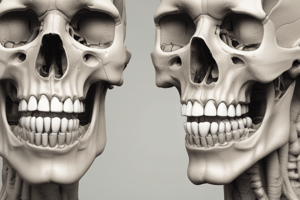Podcast
Questions and Answers
¿Cuál de las siguientes NO es una técnica utilizada en el análisis oclusal?
¿Cuál de las siguientes NO es una técnica utilizada en el análisis oclusal?
- Registro de mordida
- Palpación
- Radiografías panorámicas (correct)
- Inspección visual
¿Cuál es el propósito principal del registro de mordida?
¿Cuál es el propósito principal del registro de mordida?
- Determinar la simetría facial y las desviaciones de la línea media
- Identificar áreas de dolor o molestias en los músculos de la masticación
- Evaluar el rango de movimiento de las articulaciones temporomandibulares
- Capturar la posición relativa de los dientes superiores e inferiores durante la oclusión (correct)
¿Cuál de las siguientes afirmaciones sobre el análisis oclusal es FALSA?
¿Cuál de las siguientes afirmaciones sobre el análisis oclusal es FALSA?
- Se utiliza exclusivamente para detectar problemas de desgaste dental (correct)
- Ayuda a diagnosticar y tratar diversos problemas dentales relacionados con la oclusión
- Es esencial para garantizar la correcta colocación y funcionalidad de las restauraciones dentales
- Implica el uso de técnicas como la inspección visual y la palpación
¿Cuál de las siguientes técnicas se utiliza para evaluar los puntos de contacto entre los dientes superiores e inferiores?
¿Cuál de las siguientes técnicas se utiliza para evaluar los puntos de contacto entre los dientes superiores e inferiores?
¿Cuál de las siguientes NO es una condición que puede ser abordada mediante un análisis oclusal adecuado?
¿Cuál de las siguientes NO es una condición que puede ser abordada mediante un análisis oclusal adecuado?
Flashcards are hidden until you start studying
Study Notes
Gnathology: Occlusal Analysis
Gnathology is a branch of dentistry that deals with the study of the functions of the masticatory system. It focuses on understanding the proper functioning of the temporomandibular joints (TMJ), muscles involved in jaw movement, and the relationship between the upper and lower teeth when they come together during biting and chewing actions known as occlusion. Occlusal analysis is a crucial aspect of gnathology, helping dental professionals analyze and treat problems related to occlusion.
Objective of Occlusal Analysis
The primary objective of occlusal analysis is to examine the contact points between the upper and lower teeth to ensure optimal function and harmony within the oral cavity. This process helps identify any potential issues that may cause discomfort, pain, or damage to the teeth and surrounding tissues. By analyzing these contacts, dental professionals can determine whether changes need to be made to improve overall oral health and prevent future complications.
Techniques Used in Occlusal Analysis
Occlusal analysis involves several techniques used by dental professionals to assess the patient's bite and occlusal surfaces. These methods help detect abnormalities in the interaction between the upper and lower teeth during various functional movements such as biting, grinding, and clenching. Some common techniques used in occlusal analysis include:
-
Visual inspection: A thorough visual examination of the patient's face and mouth allows practitioners to observe any signs of asymmetry, deviations from the midline, or other irregularities that could indicate a problematic bite.
-
Palpation: Dental professionals apply manual pressure to specific areas, such as the temporomandibular joints and muscles of mastication, to evaluate their range of motion and identify any tenderness or discomfort.
-
Bite registration: A bite registration is a material used in dentistry that captures the position of the upper teeth relative to the lower ones during occlusion. This information is essential for creating custom orthodontic appliances, restorations, or dental aligners.
-
Occlusal analysis using articulating paper or foam material: By placing these materials between the upper and lower teeth while biting down, dental professionals can assess the contact points and determine if there are any discrepancies in the way the teeth come together.
Importance of Occlusal Analysis in Dentistry
Occlusal analysis plays a vital role in diagnosing and treating various dental problems related to occlusion. By understanding the function and harmony of the masticatory system, dental professionals can address issues such as tooth wear, temporomandibular joint disorders (TMJD), headaches, and even sleep apnea. Additionally, proper occlusal analysis helps ensure that dental restorations, such as crowns, bridges, and dentures, are accurately positioned and functional after treatment.
Conclusion
In summary, gnathology focuses on the functions of the masticatory system, including occlusal analysis. Occlusal analysis involves various techniques used by dental professionals to assess the contact points between upper and lower teeth and detect any potential bite-related problems. Its importance lies in its ability to help diagnose and treat various dental issues, ensuring optimal oral health and functionality.
Studying That Suits You
Use AI to generate personalized quizzes and flashcards to suit your learning preferences.




